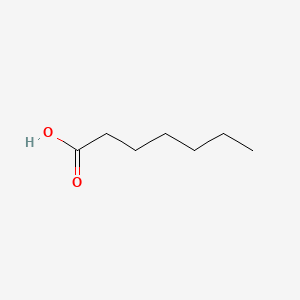| MeSH term | MeSH ID | Detail |
|---|---|---|
| Mitochondrial Diseases | D028361 | 25 associated lipids |
| Olfaction Disorders | D000857 | 17 associated lipids |
| Byssinosis | D002095 | 11 associated lipids |
HEPTANOIC ACID
HEPTANOIC ACID is a lipid of Fatty Acyls (FA) class. Heptanoic acid is associated with abnormalities such as Dehydration. The involved functions are known as Process, Anabolism, inhibitors, Oxidation and fatty acid oxidation. The related lipids are Heptanoates and undecanoic acid.
Cross Reference
Introduction
To understand associated biological information of HEPTANOIC ACID, we collected biological information of abnormalities, associated pathways, cellular/molecular locations, biological functions, related genes/proteins, lipids and common seen animal/experimental models with organized paragraphs from literatures.
What diseases are associated with HEPTANOIC ACID?
HEPTANOIC ACID is suspected in Dehydration and other diseases in descending order of the highest number of associated sentences.
Related references are mostly published in these journals:
| Disease | Cross reference | Weighted score | Related literature |
|---|
Possible diseases from mapped MeSH terms on references
We collected disease MeSH terms mapped to the references associated with HEPTANOIC ACID
PubChem Associated disorders and diseases
What pathways are associated with HEPTANOIC ACID
There are no associated biomedical information in the current reference collection.
PubChem Biomolecular Interactions and Pathways
Link to PubChem Biomolecular Interactions and PathwaysWhat cellular locations are associated with HEPTANOIC ACID?
There are no associated biomedical information in the current reference collection.
What functions are associated with HEPTANOIC ACID?
Related references are published most in these journals:
| Function | Cross reference | Weighted score | Related literatures |
|---|
What lipids are associated with HEPTANOIC ACID?
Related references are published most in these journals:
| Lipid concept | Cross reference | Weighted score | Related literatures |
|---|
What genes are associated with HEPTANOIC ACID?
There are no associated biomedical information in the current reference collection.
What common seen animal models are associated with HEPTANOIC ACID?
There are no associated biomedical information in the current reference collection.
NCBI Entrez Crosslinks
All references with HEPTANOIC ACID
Download all related citations| Authors | Title | Published | Journal | PubMed Link |
|---|---|---|---|---|
| Lacreuse A et al. | Short-term testosterone manipulations modulate visual recognition memory and some aspects of emotional reactivity in male rhesus monkeys. | 2012 | Physiol. Behav. | pmid:22361263 |
| Can Güven S and Laska M | Olfactory sensitivity and odor structure-activity relationships for aliphatic carboxylic acids in CD-1 mice. | 2012 | PLoS ONE | pmid:22479594 |
| Zhornitsky S and Stip E | Oral versus Long-Acting Injectable Antipsychotics in the Treatment of Schizophrenia and Special Populations at Risk for Treatment Nonadherence: A Systematic Review. | 2012 | Schizophr Res Treatment | pmid:22966436 |
| Poblete-Castro I et al. | The metabolic response of P. putida KT2442 producing high levels of polyhydroxyalkanoate under single- and multiple-nutrient-limited growth: highlights from a multi-level omics approach. | 2012 | Microb. Cell Fact. | pmid:22433058 |
| Mukabana WR et al. | A novel synthetic odorant blend for trapping of malaria and other African mosquito species. | 2012 | J. Chem. Ecol. | pmid:22426893 |
| Clarke JM et al. | Butyrate delivered by butyrylated starch increases distal colonic epithelial apoptosis in carcinogen-treated rats. | 2012 | Carcinogenesis | pmid:22080572 |
| Gonzales GF | Ethnobiology and Ethnopharmacology of Lepidium meyenii (Maca), a Plant from the Peruvian Highlands. | 2012 | Evid Based Complement Alternat Med | pmid:21977053 |
| Borges K and Sonnewald U | Triheptanoin--a medium chain triglyceride with odd chain fatty acids: a new anaplerotic anticonvulsant treatment? | 2012 | Epilepsy Res. | pmid:21855298 |
| Saad F et al. | Testosterone as potential effective therapy in treatment of obesity in men with testosterone deficiency: a review. | 2012 | Curr Diabetes Rev | pmid:22268394 |
| McCoy SC et al. | 17β-Hydroxyestra-4,9,11-trien-3-one (Trenbolone) preserves bone mineral density in skeletally mature orchiectomized rats without prostate enlargement. | 2012 | Bone | pmid:22842328 |
| Acebal CC et al. | Application of DV-SIA manifold for determination of thiocyanate ions in human saliva samples. | 2012 | Talanta | pmid:22817936 |
| Thomas NK et al. | Triheptanoin in acute mouse seizure models. | 2012 | Epilepsy Res. | pmid:22260920 |
| Cheema S et al. | Exploiting metagenomic diversity for novel polyhydroxyalkanoate synthases: production of a terpolymer poly(3-hydroxybutyrate-co-3-hydroxyhexanoate-co-3-hydroxyoctanoate) with a recombinant Pseudomonas putida strain. | 2012 | Bioresour. Technol. | pmid:22071242 |
| Trabado S et al. | Estradiol levels in men with congenital hypogonadotropic hypogonadism and the effects of different modalities of hormonal treatment. | 2011 | Fertil. Steril. | pmid:21536274 |
| Kinross JM et al. | Gut microbiome-host interactions in health and disease. | 2011 | Genome Med | pmid:21392406 |
| Banel A et al. | Application of headspace solid-phase microextraction followed by gas chromatography-mass spectrometry to determine short-chain alkane monocarboxylic acids in aqueous samples. | 2011 | Anal Bioanal Chem | pmid:21107976 |
| Wei J et al. | Ecological trade-offs between jasmonic acid-dependent direct and indirect plant defences in tritrophic interactions. | 2011 | New Phytol. | pmid:21039561 |
| Nazir N et al. | Evaluation of antioxidant and antimicrobial activities of Bergenin and its derivatives obtained by chemoenzymatic synthesis. | 2011 | Eur J Med Chem | pmid:21474216 |
| Xia M et al. | Identification of quaternary ammonium compounds as potent inhibitors of hERG potassium channels. | 2011 | Toxicol. Appl. Pharmacol. | pmid:21362439 |
| Wang PC et al. | Sesquiterpenoids and lignans from the roots of Valeriana officinalis L. | 2011 | Chem. Biodivers. | pmid:22006719 |
